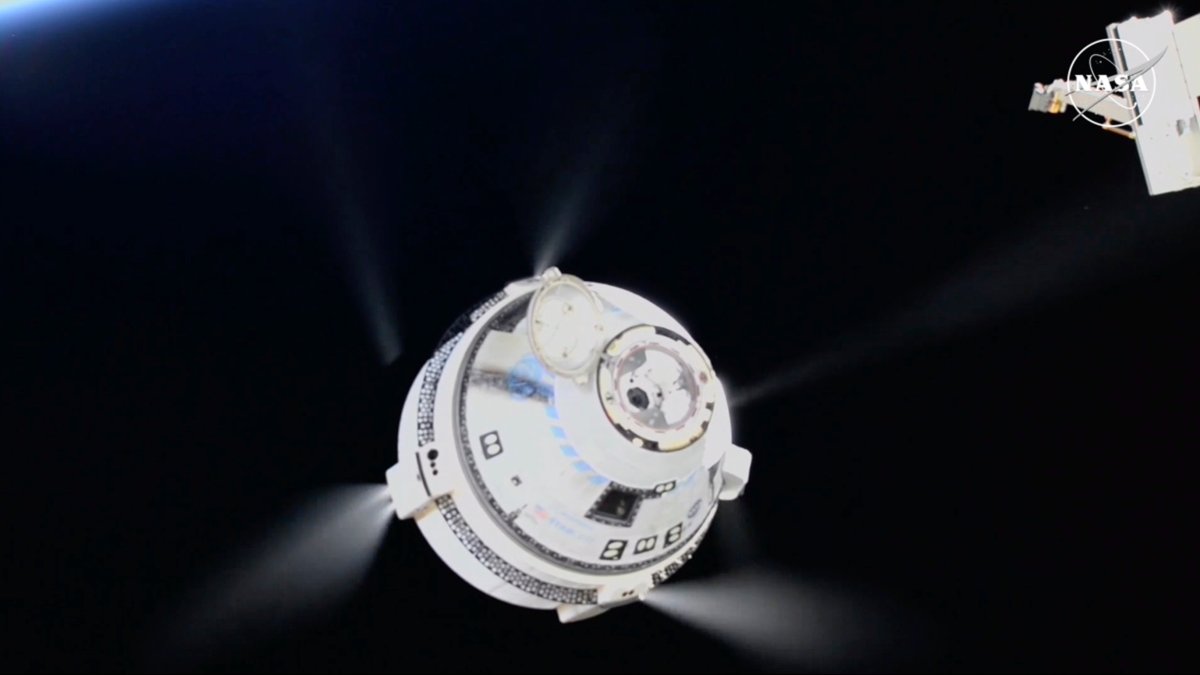Boeing’s first astronaut mission ended Friday night with an empty capsule landing and two test pilots still in space, left behind until next year because NASA judged their return too risky.
Six hours after departing the International Space Station, Starliner parachuted into New Mexico’s White Sands Missile Range, descending on autopilot through the desert darkness.
It was an uneventful close to a drama that began with the June launch of Starliner’s long-delayed crew debut and quickly escalated into a dragged-out cliffhanger of a mission stricken by thruster failures and helium leaks. For months, Butch Wilmore and Suni Williams’ return was in question as engineers struggled to understand the capsule’s problems.
Boeing insisted after extensive testing that Starliner was safe to bring the two home, but NASA disagreed and booked a flight with SpaceX instead. Their SpaceX ride won’t launch until the end of this month, which means they’ll be up there until February — more than eight months after blasting off on what should have been a quick trip.
Wilmore and Williams should have flown Starliner back to Earth by mid-June, a week after launching in it. But their ride to the space station was marred by the cascade of thruster trouble and helium loss, and NASA ultimately decided it was too risky to return them on Starliner.
So with fresh software updates, the fully automated capsule left with their empty seats and blue spacesuits along with some old station equipment.
“She’s on her way home,” Williams radioed as the white and blue-trimmed capsule undocked from the space station 260 miles (420 kilometers) over China and disappeared into the black void.
Williams stayed up late to see how everything turned out. “A good landing, pretty awesome,” said Boeing’s Mission Control.
Cameras on the space station and a pair of NASA planes caught the capsule as a white streak coming in for the touchdown, which drew cheers and applause.
Starliner’s crew demo capped a journey filled with delays and setbacks. After the space shuttles retired more than a decade ago, NASA hired Boeing and SpaceX for orbital taxi service. Boeing ran into so many problems on its first test flight with no one aboard in 2019 that it had to repeat it. The 2022 do-over uncovered even more flaws and the repair bill topped $1 billion.
SpaceX’s crew ferry flight later this month will be its 10th for NASA since 2020. The Dragon capsule will launch on the half-year expedition with only two astronauts since two seats are reserved for Wilmore and Williams for the return leg.
const iframes=document.querySelectorAll(‘iframe.ap-embed’);const iframeMap=new Map();iframes.forEach(iframe=>iframeMap.set(iframe.contentWindow,iframe));window.addEventListener(‘message’,msg=>{const iframe=iframeMap.get(msg.source);if(!iframe)return;if(msg.data.type===’embed-size’){iframe.setAttribute(‘height’,msg.data.height);iframe.style.height=”${msg.data.height}px”;return;}});iframes.forEach(iframe=>{const data={type:’embed-size-query’};iframe.contentWindow.postMessage(data,’*’);});
As veteran astronauts and retired Navy captains, Wilmore and Williams anticipated hurdles on the test flight. They’ve kept busy in space, helping with repairs and experiments. The two are now full-time station crew members along with the seven others on board.
Even before the pair launched on June 5 from Cape Canaveral, Florida, Starliner’s propulsion system was leaking helium. The leak was small and thought to be isolated, but four more cropped up after liftoff. Then five thrusters failed. Although four of the thrusters were recovered, it gave NASA pause as to whether more malfunctions might hamper the capsule’s descent from orbit.
Boeing conducted numerous thruster tests in space and on the ground over the summer, and was convinced its spacecraft could safely bring the astronauts back. But NASA could not get comfortable with the thruster situation and went with SpaceX.
Flight controllers conducted more test firings of the capsule’s thrusters following undocking; one failed to ignite. Engineers suspect the more the thrusters are fired, the hotter they become, causing protective seals to swell and obstruct the flow of propellant. They won’t be able to examine any of the parts; the section holding the thrusters was ditched just before reentry.
Cameras on the space station and later a pair of NASA planes caught the capsule as a white streak coming in for the touchdown, which drew cheers and applause.
Starliner will be transported back to NASA’s Kennedy Space Center, where the analyses will unfold.
“We will review the data and determine the next steps for the program,” Boeing program manager Mark Nappi said in a statement.
NASA’s commercial crew program manager Steve Stich said earlier this week that teams have been so focused on Starliner’s return that they’ve had no time to think about what’s next for Boeing. He said the space agency remains committed to having two competing U.S. companies transporting astronauts.
Boeing’s Starliner spacecraft carried two astronauts aboard its historic launch Wednesday from Cape Canaveral.
